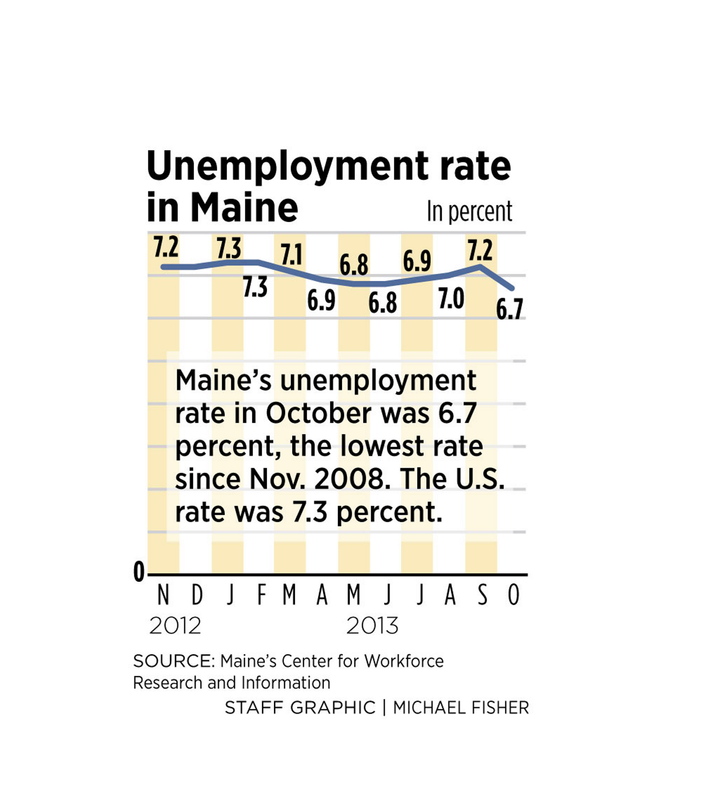The state Labor Department says the unemployment rate fell to 6.7 percent last month, the lowest since 2008.
Maine’s unemployment rate fell to 6.7 percent in October, the lowest level since November 2008, and down from 6.9 percent in September and 7.2 percent a year ago.
The state’s preliminary seasonally adjusted unemployment rate was below the national rate of 7.3 percent last month, which was little changed from 7.2 percent in September and down from 7.9 percent a year ago.
Across New England, the unemployment rate was 7.1 percent, ranging from a low of 4.5 percent in Vermont to a high of 9.2 percent in Rhode Island.
“The unemployment rate is part of a trend of pretty steady but slow improvement,” said Joel Johnson, an economist with the Maine Center for Economic Policy. “We still have a way to go.”
The state Department of Labor said the preliminary unemployment estimates will likely change in annual revisions, to be released in March.
“I don’t put a large amount of weight on that until it’s revised. It will certainly change,” said Glenn Mills, chief economist for the labor department’s Center for Workforce Research and Information. “One month doesn’t mean much – it doesn’t make a trend. But overall, the unemployment is lower and the share of the population that’s employed is up. We’re slowly, gradually improving.”
Maine has 42,600 workers who are employed only part time for economic reasons. That estimate from the Bureau of Labor Statistics indicates that those part-time workers want to work more hours but can’t find full-time employment.
John Murphy, president of the Westbrook-based Maine Credit Union League, said the organization has hired 10 people in the past few months. But he said they were primarily technical positions, and none of the successful job candidates had been out of work.
The Credit Union League, which employs more than 150 people, got a huge number of applications for each position, he said, indicating that many Mainers are still seeking a job, or at least a better one.
Nationally, the Bureau of Labor Statistics said there were 3.9 million job openings for 11.3 million job seekers in September, meaning that for every opening there were 2.9 people looking for work. That’s down from a high of 6.7-to-1 during the recession but equal to the ratio in the economic downturn in the early 2000s, according to the Economic Policy Institute.
Maine also has 9,400 workers who are “marginally attached.” That means they’re no longer in the labor force because they haven’t looked for work in a month or more, but they have looked for work in the past year.
Of those, 1,500 are “discouraged workers,” meaning they stopped looking because they believe that no jobs are available for them.
“Add marginally attached and involuntary part-time workers to the 49,400 who are officially unemployed and you get 101,400 workers – yielding a comprehensive unemployment rate of 14.1 percent – who are still struggling in a weak labor market more than four years after the recession ended,” Johnson said.
Also, the numbers don’t provide a full picture of the types of jobs that are being added and what wages and benefits are being paid, economists said.
Sixty-one percent of Maine’s population was employed in October, compared with the national average of 58.3 percent. October was the 73rd consecutive month in which the share of the employed population in Maine exceeded the national average.
The state had 600,900 nonfarm payroll jobs in October, up 3,600 from a year ago, based on preliminary estimates from the Bureau of Labor Statistics.
At its lowest point in the recession, Maine had about 591,500 jobs, down from the pre-recession peak of 621,000, Johnson said.
The non-seasonally adjusted statewide unemployment rate was 5.7 percent in October, down from 6.6 percent a year ago. The rates ranged from 4.6 percent in Cumberland and Sagadahoc counties to 8.4 percent in Washington County. Rates tended to be lower in southern and coastal counties and higher than average in northern counties.
In each of Maine’s three metropolitan areas, the unemployment rate was below the statewide average. In Portland-South Portland-Biddeford, unemployment was 4.8 percent, in Bangor it was 5.5 percent, and in Lewiston-Auburn it was 5.5 percent.
People who are on extended unemployment benefits – about 4,000 in Maine – face the loss of those benefits as of Dec. 28, barring action by Congress to extend them.
The Maine Department of Labor, which administers the state’s unemployment system, has begun warning beneficiaries of the likely termination of the program.
“People need to make financial plans,” Gov. Paul LePage said in a prepared statement. “They might also need to re-evaluate their job search strategy or change their career entirely by enrolling in a training program. … The Department of Labor has resources to help people find a good job.”
The Maine Job Bank had a record of more than 8,100 job openings on Nov. 14.
Staff Writer J. Craig Anderson contributed to this report.
Jessica Hall can be contacted at 791-6316 or at:
jhall@pressherald.com
Twitter: @JessicaHallPPH
Send questions/comments to the editors.



Comments are no longer available on this story